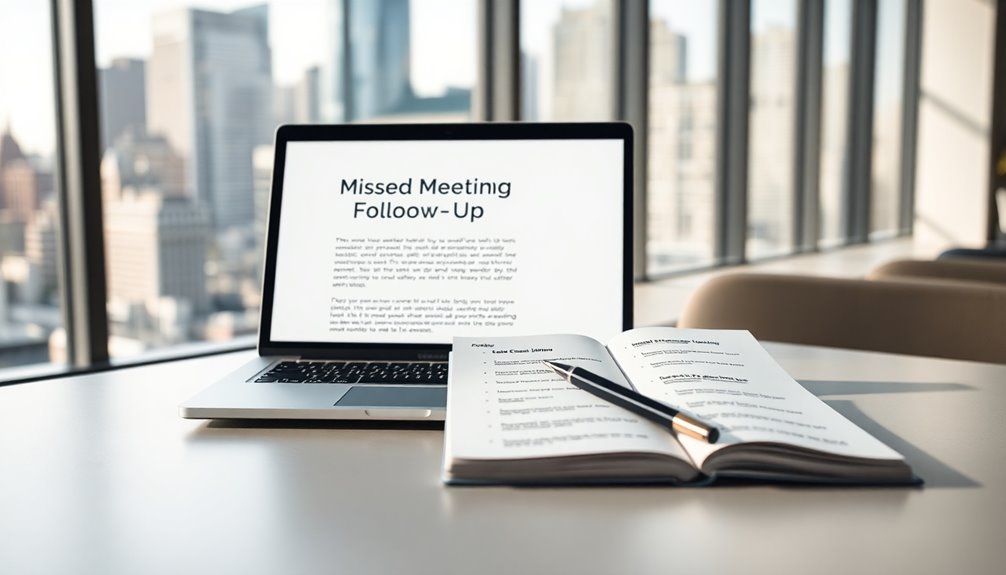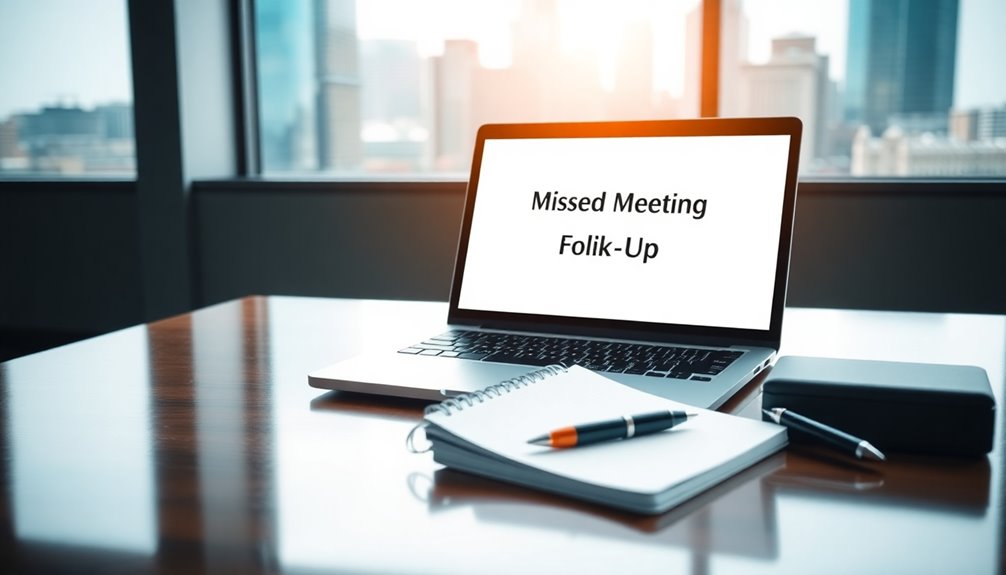If you've missed a meeting, sending a timely follow-up email can help restore professional connections. Start with a friendly greeting and acknowledge the missed meeting. Briefly restate the meeting's purpose to highlight its importance. Be polite and offer specific options for rescheduling, which shows your willingness to collaborate. Including a concise summary of key points discussed, along with any action items, keeps everyone on the same page. Remember, a respectful tone fosters positive relationships. By following these tips, you can improve your future correspondence. There's more to explore about crafting effective follow-up emails that strengthen your connections.
Key Takeaways
- Start with a courteous greeting and acknowledge the missed meeting to maintain professionalism.
- Restate the meeting's purpose and its importance to emphasize the need for rescheduling.
- Provide a brief summary of key points and action items discussed to remind the recipient of the context.
- Offer specific options for rescheduling, making it easier for the recipient to choose a new time.
- Maintain a polite and respectful tone to foster a positive atmosphere and strengthen professional relationships.
Introduction

How do you handle the situation when someone misses a meeting? It's crucial to respond professionally to maintain clear communication and ensure engagement.
A missed meeting email template can be your best friend in these situations. This structured message allows you to address the absence politely while acknowledging the missed opportunity.
Start your email by acknowledging the missed meeting, expressing understanding rather than frustration.
Then, include a brief agenda summary to remind them of what was discussed and the meeting's importance. This helps reinforce the value of their participation.
Next, propose a plan to reschedule. Including a scheduling link in your email template makes it easy for the recipient to select a new time, increasing the likelihood of a prompt follow-up.
This thoughtful approach not only enhances communication but also helps preserve relationships by showing that you value their time and input.
Maintains Professional Relationships

Maintaining professional relationships is essential in any work environment, especially when someone misses a meeting. Sending a no-show email promptly can reinforce the importance of these relationships and demonstrate respect for everyone's time.
A well-crafted follow-up email can clarify misunderstandings regarding attendance and provide an opportunity to address any obstacles the recipient may have faced. By offering to reschedule the meeting and suggesting alternative times, you show a willingness to collaborate despite the initial no-show. This approach helps maintain engagement and keeps the lines of communication open. Additionally, including key points from the missed appointment in your follow-up email ensures all parties remain informed and aligned, promoting productive future discussions. Recognizing signs of stagnation in communication can also help prevent future misunderstandings. Establishing secure attachment in professional interactions can further strengthen these relationships.
Always remember to maintain a polite tone in your no-show emails. A respectful and courteous approach fosters a positive atmosphere, which is crucial for nurturing long-term professional relationships.
Concise Meeting Summary Inclusion

Including a concise meeting summary in your follow-up email can significantly enhance understanding for those who missed the discussion. This summary should cover the key points discussed, highlighting main agenda items and critical outcomes. By doing so, you provide clarity on the meeting's purpose and ensure that everyone is on the same page.
Incorporating a brief recap of action items and deadlines reinforces accountability among team members. When people know what's expected of them, it encourages follow-through and productivity. Additionally, utilizing high-quality content in your communications can further enhance clarity and engagement.
Structuring your meeting summary effectively is essential; using bullet points can greatly enhance readability, allowing recipients to digest important information at a glance.
Moreover, a well-crafted meeting summary offers context, making it easier for recipients to grasp the importance of rescheduling the missed meeting. You want to ensure they understand not just what was discussed, but why it matters moving forward. Additionally, fostering a culture of self-care and mindfulness within the team can improve overall communication and collaboration, ensuring that everyone is engaged and present during meetings.
Crafting a Polite Follow-Up

Crafting a polite follow-up email is essential for ensuring clear communication after a missed meeting. Start your message with a courteous greeting and a polite acknowledgment of the missed meeting. This sets a positive tone and shows understanding.
Clearly restate the purpose of the missed meeting to remind the recipient of its importance. Next, you should offer specific options for rescheduling. Propose a few dates and times that work for you, making it easier for the recipient to choose a convenient time.
Maintaining a professional tone is crucial, so avoid any language that could be perceived as accusatory or guilt-inducing. Don't forget to include relevant links or documents that were discussed during the meeting. This provides context and helps the recipient engage more effectively with the follow-up email.
You're not just reaching out to fill a gap; you're creating an opportunity to reschedule and move forward collaboratively.
Pro Tips for Maximizing Impact

To make your follow-up email stand out, focus on clarity and professionalism right from the start. Use a clear subject line like "Follow-Up: Missed Meeting on [Date]" to inform the recipient of the email's purpose immediately.
Begin with a polite acknowledgment of the missed meeting, expressing understanding that unforeseen circumstances can happen. This fosters goodwill and maintains professionalism.
Next, highlight the key topics discussed or decisions made during the missed meeting. This reinforces the meeting's value and provides context for rescheduling.
Keep your message concise; stick to essential information and avoid jargon that could confuse the recipient.
To facilitate prompt action, include a scheduling link or propose specific dates and times for rescheduling. This makes it easy for the recipient to respond and streamlines the process.
Common Mistakes to Avoid

When following up on a missed meeting, it's crucial to avoid common pitfalls that can hinder effective communication. One major mistake is neglecting timeliness; if you wait too long to send a follow-up email—beyond 24 hours—it can signal a lack of urgency. Always aim to send a no-show follow-up email promptly. Additionally, ensuring that your follow-up is well-structured can significantly enhance clarity in communication and improve engagement with the recipient.
Next, be careful with your tone. Using an accusatory tone can damage relationships, so it's important to send your follow-up with a polite and understanding tone. Keep it friendly and professional.
Furthermore, don't overload your email with information. Focus on concise summaries and highlight the key action items so nothing gets overlooked.
Another critical error is failing to offer rescheduling options. Always propose new meeting times or provide a scheduling link to make it easy for the recipient to reconnect. Moreover, understanding the importance of advance directives can help ensure clear communication of expectations in future meetings.
Value Proposition Email Template

A well-structured value proposition email can effectively engage your recipient by highlighting how your product or service aligns with their specific needs.
Start by acknowledging the missed meeting and briefly summarize the meeting agenda to remind them of the discussion's relevance. This sets the stage for your value proposition, showcasing the unique benefits your offerings provide. Additionally, demonstrating your understanding of retirement planning essentials can resonate with their financial goals.
Next, incorporate client testimonials or case studies to enhance credibility. Demonstrating tangible results can make a strong case for why rescheduling is essential.
Use a professional tone throughout the email to maintain a positive rapport, making it easier for your recipient to connect with your message.
At the end of your follow-up email, propose multiple rescheduling options. This shows flexibility and consideration for their schedule, increasing the likelihood of securing a new meeting time.
Additionally, consider how your services can assist with creating a retirement savings plan, as financial security is a common concern for many professionals. By clearly articulating how your solutions address their specific needs and pain points, you create a compelling reason for them to engage with you again.
Final Thoughts

Crafting a missed meeting email can significantly impact your chances of rescheduling and maintaining a positive professional relationship.
It's essential to acknowledge the absence politely and provide a brief summary of the meeting's purpose. This approach not only demonstrates your understanding but also reinforces the importance of the discussion.
When you create your follow-up email, consider using a professional template. This can save you time while ensuring clarity and consistency in your communication.
Including a scheduling link can further facilitate easy rescheduling, showing your commitment to making things right.
Remember, maintaining a respectful tone is crucial. Avoid guilt-tripping the recipient; instead, focus on fostering a collaborative atmosphere for future engagements.
Timely follow-ups, ideally sent within a few hours of the missed meeting, significantly enhance your chances of reconnecting.
Frequently Asked Questions
How to Send a Follow-Up Email When Someone Misses a Meeting?
When someone misses a meeting, send a polite follow-up email quickly. Acknowledge the absence, summarize the agenda's importance, suggest new times, and include a scheduling link to make rescheduling easy. Keep it concise and professional.
How to Write an Email After Missing a Meeting?
When you write an email after missing a meeting, start with a polite greeting. Acknowledge the missed meeting, briefly explain the purpose, and suggest rescheduling. Attach any relevant notes to help the recipient catch up.
How Do You Politely Follow-Up on a Missed Email?
To politely follow up on a missed email, acknowledge the oversight, restate the message's importance, and gently ask for a response. Suggest a time to reconnect or provide a scheduling link to streamline coordination.
How Do You Professionally Say You Missed the Meeting?
You can say, "I noticed we missed our scheduled meeting, and I wanted to reconnect. Let's reschedule at your convenience. Here are some alternative times I'm available. I've also attached relevant materials for your reference."









